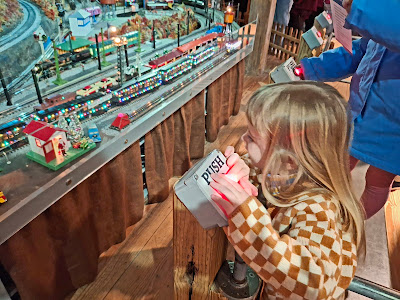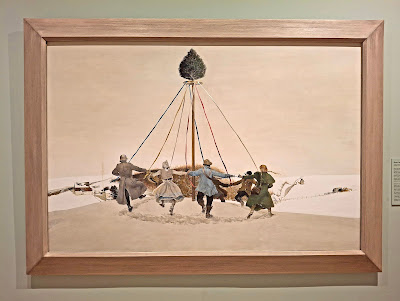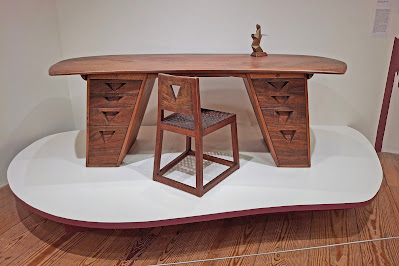Monday, November 25, 2024 (continued)
Walking Tour of Honesdale, PA Part II:
Part II combines the Government and Public Services Tour, the Religious Heritage Tour, and the Commerce and Industry Tour:
 |
105 Park Street (1911, by McCormick &
French as an armory) is now the YMCA |
 |
103 Park Street (c 1900, as the Irving Cut Glass
Company, Incorporated warehouse) |
 |
| Tallman Bridge (2009) over the Lackawaxen River |
 |
1113 Church Street/First Baptist Church (1845,
in Greek Revival style) |
 |
1019 Church Street/Central United Methodist
Church (1874, in Gothic Revival style) |
 |
| 1018 Church Street, found-object sculpture |
 |
201 10th Street/First Presbyterian Church
(1866-1868, by J P Huber in
Romanesque Revival style) |
 |
303 10th Street/Nielsen House (1886, in
Queen Anne Spindlework style) |
 |
929 Court Street/Judge Charles P Waller House (c 1843,
in Greek Revival style with 1860s Italianate porch) |
 |
921 Court Street/Walk of Honor (2016) lists all Wayne County
deceased armed service veterans with a code for their burial site |
 |
| Wayne County Walk of Honor Memorial |
 |
| 320 10th Street/Old Stone Jail (c 1858) |
 |
| Note the narrow windows of the jail cells |
 |
| Civil War Memorial (1869) |
 |
| Central Park |
 |
925 Court Street/Wayne County Courthouse
(1880, by J A Wood in Second Empire style) |
 |
901 Court Street/Dimmick House (1859,
in Second Empire style) |
 |
922 Church Street/Brown House (c 1850, in
Greek Revival style) was once the residence of
Dick Smith, who wrote the lyrics for Winter Wonderland |
 |
914 Church Street/Kingsbury House (1840s,
in center-gable Italianate style) |
 |
910 Church Street/Crane House (1845 in Greek Revival
style, 1877 alteration in Queen Anne style) |
 |
210 9th Street/Grace Episcopal Church
(1854, in Gothic Revival style) |
 |
827 Church Street/Rectory (1876, by Calvert Vaux
in Gothic Revival style) |
 |
815 Church Street/Whitney House (c 1850, in
gable-front Italianate style with Queen Anne gable
decoration), has been used since 1978 as offices for
the magazine Highlights for Children |
 |
804 Church Street/Russell House (c 1861, in
Italianate style); in 1965 it became the headquarters
for the magazine Highlights for Children |
 |
704 Church Street/St John's Evangelical
Church (1904, in Gothic Revival style) |
 |
631 Court Street/Temple Beth Israel (1856,
in Greek Revival style) |
 |
214 6th Street/Former Katz Underwear Company
(1898, 1912 addition) (KSS) |
 |
110 6th Street/Former National Hotel
(1868, in Italianate style) (KSS) |
 |
| Hmm, we just walked under that utility pole |
 |
416 Church Street/St Mary Magdalen
Catholic Church (1860, in a mix of
Greek Revival and Gothic Revival styles (KSS) |
 |
Tamiko is posing by a statue of Christ
in order to see leftover snow from a
storm on November 21-22 (KSS) |
 |
122 Terrace Street/St John Evangelist Church
(1878, in Gothic Revival style with
bell tower added in 1953) (KSS) |
 |
649-613 Main Street/Centennial Block (1875,
by J A Wood in Italianate style)
|
 |
614-622 Main Street/Murray Company Buildings
(on R 1870s, in Italianate style, on L 1907) |
 |
| 733 & 717 Main Street/Bankers Row |
 |
717 Main Street/Wayne County Savings Bank
(1924, in Neoclassical style) |
 |
733 Main Street/Honesdale National Bank
(1896, in Richardsonian Romanesque style) |
 |
810 Main Street/Former Delaware & Hudson Canal Company
Office Building (1860) is now the Wayne County Historical
Society headquarters with library and museum (KSS) |
 |
In the museum is a replica of the Stourbridge
Lion steam locomotive (1829), which was
the first foreign-built locomotive used in
the United States; it was meant to haul coal
wagons, but was found to be too heavy for
the track; the original is displayed at the
B&O Railroad Museum in Baltimore (KSS) |
 |
| The stump of a tree pulled down in the snow storm |
 |
830 Main Street/Honesdale Post Office (1935,
a Public Works Administration Class C building) (KSS) |
 |
| 867 Main Street/Masonic Lodge (1860 as Liberty Hall) |
 |
| Mural with the Stourbridge Lion (KSS) |
 |
962 Main Street/City Hall and former home of
Protection Engine Company Number 3
(1893, in Richardsonian Romanesque style) |
 |
1111 Main Street/George Mayhew Property
(1855, in Greek Revival style with
added Italianate elements) |
 |
1202 Main Street/Hotel Wayne (1892,
in Renaissance Revival style) |


























































